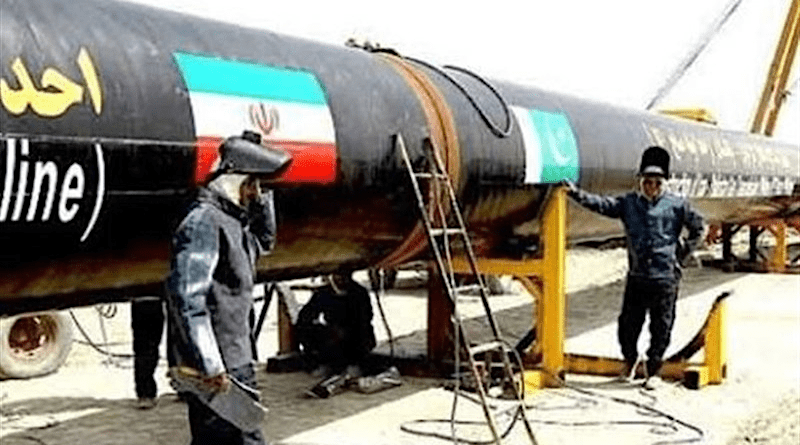US Opposition To Iran-Pakistan Gas Pipeline Risks Losing Entire Region To China – Analysis
By James Durso
On April 22, Iranian President Ebrahim Raisi, is scheduled for a state visit to Pakistan. Their number one topic probably won’t be Hamas or the Houthis, but rather a pipeline.
The Iran-Pakistan natural gas pipeline was conceived in 1950, and in 2010 — despite U.S. opposition — the countries concluded a 25-year Gas Sale and Purchase Agreement, and construction of the 2,775 km pipeline from Asaluyeh, Iran, to Multan, Pakistan. The initial cost estimate was $7.5 billion.
Pakistan suffers persistent power shortages, causing 18-hour blackouts in rural areas and 6- to 10-hour load-shedding in cities. Although Pakistan has made investments in power generation and distribution, in January 2023 the country suffered a breakdown in the national grid. Another blackout happened in October 2022.
According to the World Bank, an unreliable supply of electricity is “a significant barrier to economic growth.” One recent study found that business profitability in developing countries may be reduced up to almost 40 percent by power crises, and the U.S. Institute of Peace reports of Pakistan, “the shortages impose large costs on the economy as a whole — estimated at about 2 percent of gross domestic product annually — through lower output, exports, and employment.”
In August 2023, Pakistan announced it was suspending the project under threat of U.S. sanctions. Iran rejected Pakistan’s attempts to get out of its agreement, but granted a 10-year extension, and both sides got to work on a way forward. The Iran-Pakistan natural gas pipeline was already behind schedule (Iran has completed its leg of the pipeline) and Pakistan was facing an $18 billion penalty at the time the Americans intervened.
In February 2024, Pakistan approved the first phase of the pipeline, and in March 2024 announced it would ask the U.S. to relax sanctions so that the project could proceed. The U.S. promptly responded that “importing gas from Iran would expose Pakistan to U.S. sanctions.”
Pakistan wants to avoid the $18 billion penalty, and Iran has set September 2024 as the deadline to finish the 780-kilometer Pakistan section of the pipeline.
With the pipeline looking uncertain, one alternative is the Central Asia-South Asia power project, a $1.16 billion plan to export surplus hydroelectricity from Kyrgyzstan and Tajikistan to Afghanistan and Pakistan. The U.S. Agency for International Development expects a commercial start in 2024, but that may slip if Afghanistan cannot build power pylons and other facilities. And is it possible to expand the project if Pakistan loses Iranian gas for power generation?
Another potential energy source is the Turkmenistan-Afghanistan-Pakistan-India natural gas pipeline, an 1,100-mile, $10 billion project to ship 33 billion cubic meters of gas per year that has seen numerous delays since the pipeline consortium was announced in 2014. Construction started in early 2018 with a projected in-service date of 2021, but halted later that year after workers clearing the route were killed by unknown assailants. The project’s $10 billion cost estimate is now a decade old, and an update may cause further delay to the Asian Development Bank-funded effort.
In June 2023, the United Nations reported conflict between personalities within the Taliban government, which may further delay this project as well, even as Pakistan’s energy deficit worsens. Despite (or perhaps because of) the Taliban infighting, officials from Pakistan and Turkmenistan met in Islamabad in June 2023 and signed a Joint Implementation Plan, committing both sides to speeding up implementation.
Pakistan’s loss of Iranian natural gas may benefit the U.S. from a trade perspective, as it may create a dependency in Pakistan on American liquified natural gas, as in Europe after the sabotage of the Nord Stream pipeline and the cancellation of the EastMed gas pipeline.
Pakistan may eventually move away from gas and quadruple domestic coal-fired power instead, but this will make its already bad air quality even worse. If Pakistan decides to adopt sustainable and green electricity generation, that will open the door for China, the world’s leader in renewable power and supplier of solar panels.
The Americans already disrupted the region with their failed war in Afghanistan. The gratuitous kneecapping of a needed energy project demonstrates Washington’s heedless pursuit of revenge for its 1979 humiliation in Tehran, regardless of the cost to others. U.S. actions will likely reanimate anti-Americanism — never far beneath the surface — limiting the efforts of Pakistan’s government to move closer to the U.S. and limit its dependence on China.
Another American aim may be to starve the China-Pakistan Economic Corridor, the $62 billion project to connect Kashgar, China, to Pakistan’s Gwadar port. The corridor is a major component of Beijing’s Belt and Road Initiative, consisting of highways, railways and pipelines. The inability of CPEC to supply water and power to Balochistan, Pakistan’s poorest region, may increase violence by the Baloch insurgency against Chinese companies.
The winner in all this is China, Pakistan’s “all-weather friend.” China’s minister of foreign affairs, Wang Yi, will probably dispense with “I told you so” and start talking up “win-win” solutions as he steers Pakistan even more into China’s corner.
China’s big investments in Pakistan, its “lifeline” energy purchases from Iran, its patience and realism in Afghanistan, and its increasing ties in Central Asia, where it has proposed a China-Central Asia cooperation mechanism and entered into Comprehensive Strategic Partnerships with former Soviet republics, shows it is “gathering in” countries with natural resources occupying strategic locations in Eurasia.
The Central Asian republics want good ties with the U.S., but Washington must avoid policies that damage their economies and endanger needed projects like the Trans-Afghan Railway that will link Uzbekistan (and all Central Asia) to Pakistan. Otherwise, U.S. policies will ensure Russia and China will make gains with minimal effort.
- Source: This article was published at The Hill

